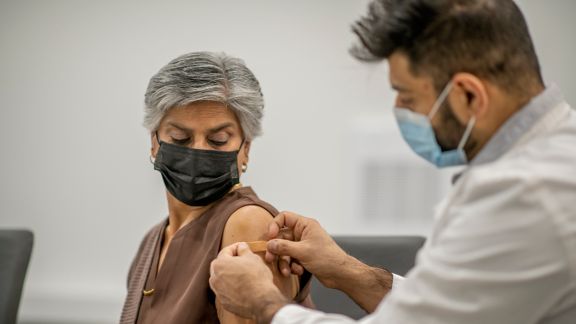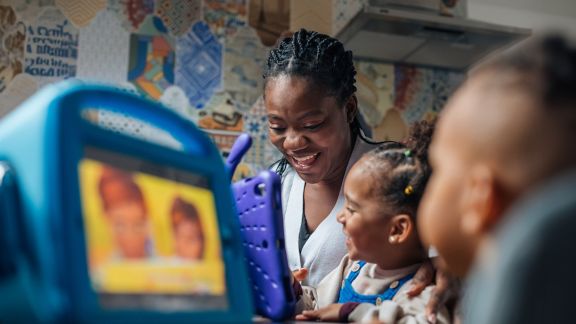Older Adults’ Concern About Misinformation Is Lower Since the Pandemic

Foresight 50+
Foresight 50+ by AARP and NORC offers deep insight into the views and behaviors of Americans 50 and older.
For inquiries, contact us:
November 2024
A recent Foresight 50+ Omnibus Survey reveals that adults 50 and older are less concerned about misinformation compared to 2022.
While their concern has decreased overall, older adults remain more worried about exposure to misinformation than spreading it. According to the survey, 31 percent of adults age 50 and older are concerned about being exposed to misinformation, a drop from 44 percent in 2022. Similarly, 29 percent are concerned about their family members’ exposure, down from 47 percent in 2022.
Misinformation refers to any claims that are false with or without the intent to mislead people, sometimes called fake news or disinformation. Fewer older adults are concerned about potentially spreading misinformation, with just 10 percent expressing worry that their family might knowingly or unknowingly spread misinformation and 9 percent expressing concern that they may do so themselves.
Among older adults who care for an adult friend or relative, 25 percent express concern about those they care for being exposed to misinformation. To combat this exposure, 31 percent said they have provided credible evidence against the misinformation to the person they are caring for. Another 28 percent said they have shown them how to identify misinformation.
Adults 50 and older have become less concerned about themselves or their family members being exposed to or spreading misinformation.
Concern among older adults about themselves or their family members being exposed to misinformation has declined since 2022. Older adults are also less likely to be concerned that they or their family members have intentionally or unintentionally spread misinformation. Older adults have consistently been more concerned about exposure to misinformation than about spreading it.

To determine whether something is misinformation, older adults most commonly say they learn more about the source, ask themselves if the information seems credible, or conduct online searches. Fewer than 1 in 5 say they listen to people they trust but do not know personally to make this determination. Eight percent of older adults believe they have never been exposed to misinformation.

Twenty-five percent of older adults who are caregivers to an adult friend or relative are extremely or very concerned that the person they care for has been exposed to misinformation, 28 percent are somewhat concerned, and 47 percent are not very or not at all concerned.

When they suspect that the person they care for has consumed misinformation, about 3 in 10 older adult caregivers say they have provided credible evidence that it is false or discussed how to identify misinformation with them. Another 30 percent of older adult caregivers do not believe the person they care for is consuming misinformation, while 13 percent believe they are consuming misinformation but have not taken any action to correct it.

Methodology
This Foresight 50+ Omnibus Survey was conducted August 15-19, 2024, with 1,000 U.S. adults 50 years and older online and over the phone. The survey included select questions from the 2022 Pearson Institute/AP-NORC Poll conducted September 9-12, 2022, with 1,003 adults nationwide to compare results. Only respondents 50 and older to the Pearson Institute/AP-NORC Poll were included in these comparisons. The margin of sampling error is +/- 4.3 percentage points.
This is part of the series of Foresight 50+ Omnibus Surveys focused on amplifying the voices of people 50 and older. Now more than ever, policymakers and others need this type of scientifically rigorous and readily available data in real time to help them improve policies and programs for an aging population. The Foresight 50+ FastTrack series—a set of periodic insights using the panel—meets this need by regularly providing key findings and insights on an array of topics that might otherwise be unavailable to the public. The series also showcases ways your organization can use the panel to answer your questions about the highly influential 50+ demographic.
The large Foresight 50+ panel by AARP and NORC can oversample a variety of target groups, such as Medicare beneficiaries, caregivers, those with various health conditions or functional limitations, veterans, frequent travelers, and others. Combined with our affordable TrueNorth methodology, Foresight 50+ by AARP and NORC can incorporate data from lower-quality sample sources to gain insight into even smaller subpopulations, such as people with food allergies, socially isolated or homebound individuals, and high net-worth individuals.
For more information on our other surveys or to learn how we can customize a survey of this demographic to your needs, visit Foresight 50+ or email Foresight50-bd@norc.org. To learn more about how NORC delivers objective, nonpartisan insights and analysis that decision-makers trust across other issue areas and demographics, continue to explore NORC.org.





